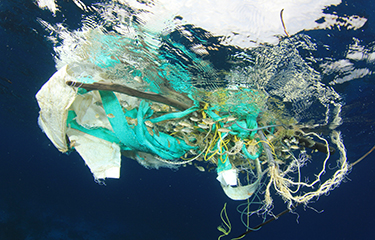Plastic litter is a serious problem affecting the marine environment, with current estimates indicating there is anywhere from 27 to 66.7 million metric tons of plastic currently in the world’s oceans and rivers. That number now grows every year by more than 12 million metric tons, notes environmental consultancy Eunomia – and the resulting ecological, social, and economic costs are considerable.
Three-quarters of marine plastic litter (74 percent) originates from land, 9.4 percent from fishing litter, 7.8 percent from primary microplastics, and 4.9 percent from shipping litter, Eunomia reports.
Traditionally, waste plastics from aquaculture and capture fisheries have been considered together, but the Aquaculture Stewardship Council (ASC) believes that this is not helpful to the industry, as the causes are different.
A great deal of attention has been paid to how much abandoned, lost, and discarded fishing gear, as well as ghost fishing, entanglement, and habitat damage contribute to marine plastic litter levels. However, less emphasis has been placed on understanding the plastics issue as it relates to aquaculture, according to a new ASC white paper, “Marine Litter and Aquaculture Gear." In the paper, the ASC sets out to address this imbalance, by classifying the different causes of plastic waste from aquaculture, and assessing the risks to different farming systems.
The white paper is timely, given that aquaculture already supplies more than half of the world’s seafood, and the industry will gain greater importance over the coming decades, as the global population increases and wild marine resources remain at current population levels or diminish, ASC Standards Coordinator Marcelo Hidalgo told SeafoodSource.
“One of the reasons for commissioning this white paper was to provide research and science for the development of industry-leading ASC requirements for plastics. But it has also demonstrated just how important it is that the whole industry looks at these issues, and works together to tackle them,” Hidalgo said. “ASC plans to be the first aquaculture certification scheme to include specific requirements for plastics, and as a science-based organisation it was important for us to make sure they are evidence-based.”
ASC’s research found that aquaculture makes extensive use of plastics for both equipment and packaging, with plastic materials used in everything from polystyrene foam-filled fish cage collars and polymer-coated cage nets to plastic harvest bins and feed sacks.
The study looked at more than 60 ASC-certified farms that use ocean water cages and pens, inland ponds, and suspended rope and cage systems. It found that the most likely causes of plastic loss were extreme weather, poor waste management, and installation wear, and failure resulting from poor siting or lack of maintenance.
The push to move aquaculture further offshore means that sea cages are often moored in exposed sites which are vulnerable to strong winds and high waves. The white paper warns that increasingly unpredictable weather caused by climate change could exacerbate this issue.
Coastal ponds are vulnerable to storm surges and inland flooding, which can wash unsecured equipment into the sea and potentially damage adjacent coral reefs, mangroves, and coastal wetland areas, the ASC report posits. Many coastal pond systems are found in developing countries, where there may be little awareness about the impacts of lost plastics, and the need to ensure they are stored and disposed of responsibly, along with a lack infrastructure for plastic collection and recycling.
Abandoned or decommissioned coastal pond farms are also a growing issue, as large items such as pond liners are left to disintegrate and disperse into the environment, ASC said.
The white paper concludes that while it is currently impossible to estimate the contribution of aquaculture to the marine plastic stock, it is probably localized and relatively low compared to capture fisheries. Recommendations are that greater efforts should be made to reduce plastic use, end of life plastic components should be reused and recycled, and lost plastics and other aquaculture-derived debris recovered, if aquaculture is to stem its contribution to the global plastics problem.
The findings will now be shared with the United Nations Food and Agricultural Organization (FAO), the International Maritime Organization (IMO), and the Global Ghost Gear Initiative (GGGI), ASC said. The certifier hopes that by working together, solutions can be found.
“The recommendations in the paper can help the entire industry prevent the effects of plastic pollution and ghost gear. In some cases, they can also result in economic benefits to farms as well as environmental benefits – for example using more durable and long lasting equipment rather than single-use equivalents. This is an issue that affects us all, and we all need to work together to provide solutions,” Hidalgo said.
Photo courtesy of Rich Carey/Shutterstock







